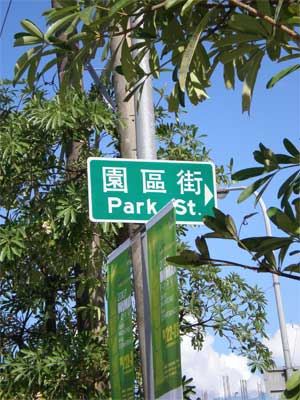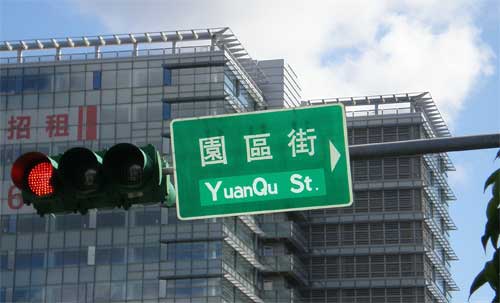I have spent many hours over the past few days trying to find out exactly what is behind the recent news story about the Ministry of Education and moves to expand Tongyong Pinyin by the end of the year.
I have sent out no fewer than five e-mail messages to various government officials but have received no responses. I have also made more than a dozen phone calls to various ministries and government-information lines. But nobody I spoke with knows what is going on. My wife helped by making some calls on her own. She was eventually able to get through to someone at the Ministry of the Interior who does have a clue about all this.
Here is basically what is happening.
On October 30, Taiwan’s Ministry of the Interior promulgated the government’s guidelines for writing place names (including not just town names but physical features, such as rivers, mountains, temples, bridges, etc.) in English and romanization: Yùgào dìngdìng “biāozhǔn dìmíng yì xiě zhǔnzé” (預告訂定「標準地名譯寫準則」) (MS Word document).
Most of the pages of this document are simply a list of townships and districts throughout Taiwan, as given in Tongyong Pinyin. But it also contains a few pages of general guidelines. Local governments and interested individuals (yes, that could include you, o reader) who wish to comment on these guidelines may do so before the deadline of Thursday, November 8. The question of Tongyong Pinyin vs. Hanyu Pinyin, however, is supposedly off the table, as the Ministry of the Interior must follow the administration in this — though I encourage anyone who writes the ministry to bring up the issue anyway. I will post contact information as soon as I get it.
To return to the matter of the promulgated document, these are the guidelines that Taiwan’s local governments are ordered to use, with local governments’ offices of land administration compiling lists of place names to be standardized within their jurisdictions and submitting these lists to the MOI’s Department of Land Administration (dìzhèng sī fāngyù kē / 地政司方域科).
If local governments reject Tongyong Pinyin and use a different romanization system, the MOI does not have the authority to compel them to switch to Tongyong. But the central government can and and almost certainly will exert pressure on them to toe the line.
Making matters worse for advocates of Hanyu Pinyin, the international standard romanization system for Mandarin, is the fact that many local officials — even in “blue” regions — do not believe they have autonomy in this matter, as I know from having spoken with several of them about precisely this topic. Nor, unsurprisingly, do they take the word of a foreigner over what they “know” to be “correct”: that they must use Tongyong whether they like it or not. As an example, the city of Jilong (”Keelung”), which is controlled by the anti-Tongyong “blues,” instituted a plan to standardize street names there with Tongyong Pinyin. Nor will most officials bother to look up the rule they are supposedly following — and which, BTW, I can’t show them because it doesn’t exist.
The recently promulgated proposal has extremely limited guidelines. These are most certainly inferior to the fuller guidelines for Hanyu Pinyin — to say nothing of the book-length supplementary guidelines for Hanyu Pinyin (Chinese Romanization: Pronunciation and Orthography and the Xinhua Pinxie Cidian) and carefully produced dictionaries in Hanyu Pinyin.
Probably the best thing I could say about the guidelines is a negative: At least they didn’t adopt Taipei’s StuPid, StuPid PolICy Of InTerCapITaLiZaTion.
The problem that is likely to affect more names than other deficiencies — other than the fundamental matter of Tongyong Pinyin, that is — is the recommended use of the hyphen. Basically, the guidelines call for a hyphen where Hanyu Pinyin would use an apostrophe: before any syllable that begins with a, e, or o, unless that syllable comes at the beginning of a word or immediately follows a hyphen or other dash.
The reason that is a big problem, beyond the failure to follow the standard of Hanyu Pinyin, is that hyphens cannot then be put to the good use they have in Hanyu Pinyin. Hyphens are often needed in signage because they are used in short forms of proper nouns, for example the correct short form of Taiwan Daxue (National Taiwan University) is “Tai-Da.”
Hyphens can thus help clarify names a great deal becuase they often indicate an abbreviation. Mandarin’s tendency toward Consider bridge names, in which the hyphen helps indicates the reason for the name:
- not Huazhong but Hua-Zhong (for [Wan]hua to Zhong[he])
- not Huajiang but Hua-Jiang (for [Wan]hua to Jiang[zicui])
Or the case given in the guidelines of 嘉南大圳. The recommendation there is for “Jianan dazun.” But giving “Jia-Nan” instead of “Jianan” would help clarify that this is something in Jiayi and Tainan counties.
The government guidelines’ failure to employ the hyphen in the same manner as Hanyu Pinyin is a major deficiency.
Taiwan should have Tongyong Pinyin’s orthography follow the well-established guidelines for Hanyu Pinyin. But the administration’s petty difference-for-the-sake-of-difference policy will likely rule out that course.

 Ah, Park Street: Taipei’s lovely tree-lined boulevard next to a wonderful oasis of well-manicured nature.
Ah, Park Street: Taipei’s lovely tree-lined boulevard next to a wonderful oasis of well-manicured nature. 